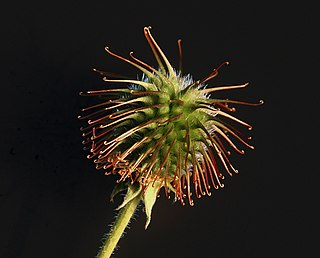
Biomimetics or biomimicry is the emulation of the models, systems, and elements of nature for the purpose of solving complex human problems. The terms "biomimetics" and "biomimicry" are derived from Ancient Greek: βίος (bios), life, and μίμησις (mīmēsis), imitation, from μιμεῖσθαι (mīmeisthai), to imitate, from μῖμος (mimos), actor. A closely related field is bionics.

A photonic crystal is an optical nanostructure in which the refractive index changes periodically. This affects the propagation of light in the same way that the structure of natural crystals gives rise to X-ray diffraction and that the atomic lattices of semiconductors affect their conductivity of electrons. Photonic crystals occur in nature in the form of structural coloration and animal reflectors, and, as artificially produced, promise to be useful in a range of applications.

Iridescence is the phenomenon of certain surfaces that appear to gradually change colour as the angle of view or the angle of illumination changes. Iridescence is caused by wave interference of light in microstructures or thin films. Examples of iridescence include soap bubbles, feathers, butterfly wings and seashell nacre, and minerals such as opal. Pearlescence is a related effect where some or most of the reflected light is white. The term pearlescent is used to describe certain paint finishes, usually in the automotive industry, which actually produce iridescent effects.

A metamaterial is any material engineered to have a property that is rarely observed in naturally occurring materials. They are made from assemblies of multiple elements fashioned from composite materials such as metals and plastics. These materials are usually arranged in repeating patterns, at scales that are smaller than the wavelengths of the phenomena they influence. Metamaterials derive their properties not from the properties of the base materials, but from their newly designed structures. Their precise shape, geometry, size, orientation and arrangement gives them their smart properties capable of manipulating electromagnetic waves: by blocking, absorbing, enhancing, or bending waves, to achieve benefits that go beyond what is possible with conventional materials.
Optical computing or photonic computing uses light waves produced by lasers or incoherent sources for data processing, data storage or data communication for computing. For decades, photons have shown promise to enable a higher bandwidth than the electrons used in conventional computers.

A distributed Bragg reflector (DBR) is a reflector used in waveguides, such as optical fibers. It is a structure formed from multiple layers of alternating materials with different refractive index, or by periodic variation of some characteristic of a dielectric waveguide, resulting in periodic variation in the effective refractive index in the guide. Each layer boundary causes a partial reflection and refraction of an optical wave. For waves whose vacuum wavelength is close to four times the optical thickness of the layers, the interaction between these beams generates constructive interference, and the layers act as a high-quality reflector. The range of wavelengths that are reflected is called the photonic stopband. Within this range of wavelengths, light is "forbidden" to propagate in the structure.
Nanophotonics or nano-optics is the study of the behavior of light on the nanometer scale, and of the interaction of nanometer-scale objects with light. It is a branch of optics, optical engineering, electrical engineering, and nanotechnology. It often involves dielectric structures such as nanoantennas, or metallic components, which can transport and focus light via surface plasmon polaritons.

Harry Albert Atwater, Jr. is an American physicist and materials scientist and is the Otis Booth Leadership Chair of the division of engineering and applied science at the California Institute of Technology. Currently he is the Howard Hughes Professor of Applied Physics and Materials Science and the director for the Liquid Sunlight Alliance (LiSA), a Department of Energy Hub program for solar fuels. Atwater's scientific effort focuses on nanophotonic light-matter interactions and solar energy conversion. His current research in energy centers on high efficiency photovoltaics, carbon capture and removal, and photoelectrochemical processes for generation of solar fuels. His research has resulted in world records for solar photovoltaic conversion and photoelectrochemical water splitting. His work also spans fundamental nanophotonic phenomena, in plasmonics and 2D materials, and also applications including active metasurfaces and optical propulsion.
Reflectins are a family of intrinsically disordered proteins evolved by a certain number of cephalopods including Euprymna scolopes and Doryteuthis opalescens to produce iridescent camouflage and signaling. The recently identified protein family is enriched in aromatic and sulfur-containing amino acids, and is utilized by certain cephalopods to refract incident light in their environment. The reflectin protein is responsible for dynamic pigmentation and iridescence in organisms. This process is “dynamic” due to its reversible properties, allowing reflectin to change an organism's appearance in response to external factors such as needing to camouflage or send warning signals.

A colloidal crystal is an ordered array of colloidal particles and fine grained materials analogous to a standard crystal whose repeating subunits are atoms or molecules. A natural example of this phenomenon can be found in the gem opal, where spheres of silica assume a close-packed locally periodic structure under moderate compression. Bulk properties of a colloidal crystal depend on composition, particle size, packing arrangement, and degree of regularity. Applications include photonics, materials processing, and the study of self-assembly and phase transitions.

Multiphoton lithography of polymer templates has been known for years by the photonic crystal community. Similar to standard photolithography techniques, structuring is accomplished by illuminating negative-tone or positive-tone photoresists via light of a well-defined wavelength. A critical difference is, however, the avoidance of photomasks. Instead, two-photon absorption is utilized to induce a dramatic change in the solubility of the resist for appropriate developers.
A nanolaser is a laser that has nanoscale dimensions and it refers to a micro-/nano- device which can emit light with light or electric excitation of nanowires or other nanomaterials that serve as resonators. A standard feature of nanolasers includes their light confinement on a scale approaching or suppressing the diffraction limit of light. These tiny lasers can be modulated quickly and, combined with their small footprint, this makes them ideal candidates for on-chip optical computing.

A photonic metamaterial (PM), also known as an optical metamaterial, is a type of electromagnetic metamaterial, that interacts with light, covering terahertz (THz), infrared (IR) or visible wavelengths. The materials employ a periodic, cellular structure.
A metamaterial absorber is a type of metamaterial intended to efficiently absorb electromagnetic radiation such as light. Furthermore, metamaterials are an advance in materials science. Hence, those metamaterials that are designed to be absorbers offer benefits over conventional absorbers such as further miniaturization, wider adaptability, and increased effectiveness. Intended applications for the metamaterial absorber include emitters, photodetectors, sensors, spatial light modulators, infrared camouflage, wireless communication, and use in solar photovoltaics and thermophotovoltaics.

Structural coloration in animals, and a few plants, is the production of colour by microscopically structured surfaces fine enough to interfere with visible light instead of pigments, although some structural coloration occurs in combination with pigments. For example, peacock tail feathers are pigmented brown, but their microscopic structure makes them also reflect blue, turquoise, and green light, and they are often iridescent.
Photonic molecules are a form of matter in which photons bind together to form "molecules". They were first predicted in 2007. Photonic molecules are formed when individual (massless) photons "interact with each other so strongly that they act as though they have mass". In an alternative definition, photons confined to two or more coupled optical cavities also reproduce the physics of interacting atomic energy levels, and have been termed as photonic molecules.

Plasmonics or nanoplasmonics refers to the generation, detection, and manipulation of signals at optical frequencies along metal-dielectric interfaces in the nanometer scale. Inspired by photonics, plasmonics follows the trend of miniaturizing optical devices, and finds applications in sensing, microscopy, optical communications, and bio-photonics.

An electromagnetic metasurface refers to a kind of artificial sheet material with sub-wavelength thickness. Metasurfaces can be either structured or unstructured with subwavelength-scaled patterns in the horizontal dimensions.
Silvia Vignolini is an Italian physicist who is Director of research at the Max Planck Institute of Colloids and Interfaces and Professor of Chemistry and Bio-materials in the Yusuf Hamied Department of Chemistry at the University of Cambridge. Her research investigates natural photonics structures, the self-assembly of cellulose and light propagation through complex structures. She was awarded the KINGFA young investigator award by the American Chemical Society and the Gibson-Fawcett Award in 2018.
In photonics, a meta-waveguide is a physical structures that guides electromagnetic waves with engineered functional subwavelength structures. Meta-waveguides are the result of combining the fields of metamaterials and metasurfaces into integrated optics. The design of the subwavelength architecture allows exotic waveguiding phenomena to be explored.
















